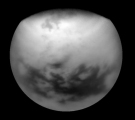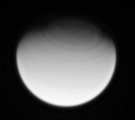Titan Flyby - 26 March 2007
23 March 2007
Just 16 days after Titan-26, Cassini returns to Titan for its twenty-eighth targeted encounter. The closest approach to Titan occurs on Monday, 26 March 2007 at 00:23 UT at an altitude of 1010 kilometres above the surface and at a speed of 6.2 kilometres per second. The latitude at closest approach is 41.1° N and the encounter occurs on orbit number 41.Around closest approach, Cassini passes behind Titan for approximately 35 minutes as seen from Earth. This flyby configuration allows for radio observations to be made of Titan's atmosphere, with a radio signal passing through the atmosphere which is subsequently received on Earth. In addition bistatic radio measurements will be made of the moon's surface, by sending a radio signal at grazing angles, which after bouncing of Titan's surface is received on Earth and provides information on the surface properties.
This encounter is set up with two manoeuvres: an apoapsis manoeuvre on 17 March, and an approach manoeuvre, scheduled for 22 March. This is the third in a series of outbound Titan encounters (series ends with T33, 29 June 2007) and occurs about 3 days after Saturn closest approach.
Science Activities
- Radio Science Subsystem (RSS)
A T27 ingress/egress occultation of Titan's atmosphere will provide a high-spatial-resolution electron number density profile of the ionosphere, temperature-pressure and absorption profiles of the neutral atmosphere, as well as information about the small-scale structure of the atmosphere. The ingress latitude is -71.3° and the egress latitude is 54°. The previous two RSS Titan occultations had ingress latitudes of -29° and -30.9°. The previous egress latitudes were -49° and -32.5°. T31 (28 May 2007) will be the fourth and final RSS Titan occultation and it will have an ingress latitude of -75.4° and an egress latitude of 74.6°.
In addition, inbound and outbound RSS bistatic scattering observations of Titan's surface will provide information about the dielectric constant, nature, and roughness of the region probed. This RSS bistatic observation is in the deep southern hemisphere, over one of the very large dark regions shown in the imaging data. In the north, these large dark regions have turned out to be most likely hydrocarbon seas and lakes. - Ultraviolet Imaging Spectrograph (UVIS)
UVIS will perform several slow scans across Titan's visible hemisphere to form spectral images. - Imaging Science Subsystem (ISS)
Extending coverage north of Belet and Adiri. - Composite Infrared Spectrometer (CIRS)
Inbound CIRS is doing a far-IR composition integration and a mid-IR limb composition integration. Outbound CIRS is doing a far-IR limb composition integration, far-IR surface temperature scan, and a mid-IR composition integration.
Table of Events
17 February 2007
| Time UTC | Time wrt Titan-27 |
Activity |
| 10:52:00 | -36d 14h | Start of sequence S28 which contains Titan-27 |
22 March 2007
| Time UTC | Time wrt Titan-27 |
Activity |
| 14:30:00 | -03d 10h | OTM #100 prime. Titan-27 targeting manoeuvre |
| 15:46:00 | -03d 09h | Descending ring plane crossing |
23 March 2007
| Time UTC | Time wrt Titan-27 |
Activity |
| 11:57:00 | -02d 12h | Saturn periapse, r = 12.1 RS, latitude= -54°, phase = 83° |
| 23:20:00 | -02d 01h | OTM #100 backup |
25 March 2007
| Time UTC | Time wrt Titan-27 |
Activity |
| 08:50:00 | -15h 33m | Turn cameras to Titan |
| 08:50:00 | -15h 33m | Deadtime, 17 minutes 27 seconds long; used to accommodate changes in flyby time |
| 09:07:27 | -15h 16m | Titan atmospheric observations. Obtain information on the thermal structure of Titan's stratosphere |
| 11:23:27 | -13h 00m | Titan atmospheric observations. Obtain information on trace constituents in Titan's stratosphere |
| 14:23:27 | -10h 00m | ISS imaging. WAC photometry |
| 15:23:27 | -09h 00m | Titan atmospheric observations. Obtain information on trace constituents in Titan's stratosphere |
| 19:23:27 | -05h 00m | ISS imaging. Search for and monitor lightning/aurora |
| 20:23:27 | -04h 00m | Transition to thruster control |
| 20:49:27 | -03h 34m | Titan atmospheric observations. Several slow scans across Titan's visible hemisphere to form spectral images |
| 23:12:27 | -01h 11m | New waypoint |
| 23:25:27 | -00h 58m | RSS observations. Bistatic scattering measurements at three radio wavelengths to determine the physical properties of Titan's surface, including reflectivity, dielectric constant, and roughness |
26 March 2007
| Time UTC | Time wrt Titan-27 |
Activity |
| 00:00:03 | -00h 23m | RSS occultation of Titan's atmosphere on ingress, atmosphere and ionosphere on egress |
| 00:23:27 | +00h 00m | Titan-27 flyby closest approach time. Altitude = 1010 km, speed = 6.2 kms-1; 150° phase at closest approach |
| 00:28:00 | +00h 05m | Ascending ring plane crossing |
| 00:35:25 | +00h 12m | RSS observations. Bistatic scattering measurements at three radio wavelengths to determine the physical properties of Titan's surface, including reflectivity, dielectric constant, and roughness |
| 01:23:27 | +01h 00m | New waypoint |
| 01:56:27 | +01h 33m | Titan atmospheric observations. Vertical sounding of stratospheric compounds on Titan, including H2O. Integrations at two locations on the limb displaced vertically |
| 02:38:27 | +02h 15m | Titan atmospheric observations. Obtain information on surface & tropopause temperatures |
| 03:23:27 | +03h 00m | Titan atmospheric observations. Several slow scans across Titan's visible hemisphere to form spectral images |
| 08:23:27 | +08h 00m | ISS imaging. Global map and WAC photometry |
| 09:23:27 | +09h 00m | Titan atmospheric observations. Obtain information on trace constituents in Titan's stratosphere |
| 11:23:27 | +11h 00m | ISS imaging. Monitoring for surface/atmosphere changes |
| 13:23:27 | +13h 00m | Titan atmospheric observations. Global mapping |
| 21:38:27 | +21h 15m | Deadtime, 13 minutes 33 seconds long. Used to accommodate changes in flyby time |
| 21:52:00 | +21h 29m | Turn to Earth-line |
| 22:22:00 | +21h 59m | Playback of T27 data. Goldstone 70M |
Observation Results
Cassini Instrument: Imaging Science Subsystem (ISS)



